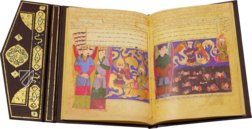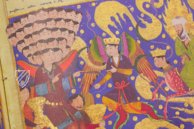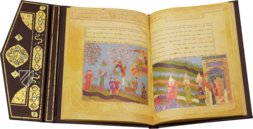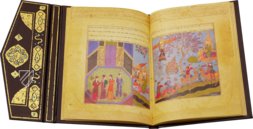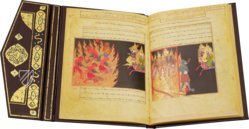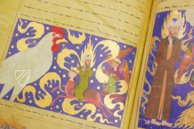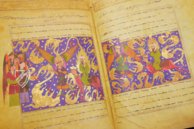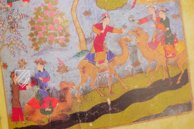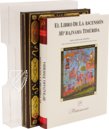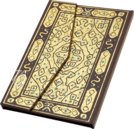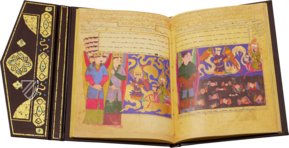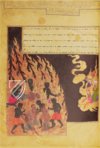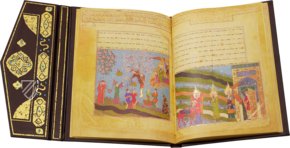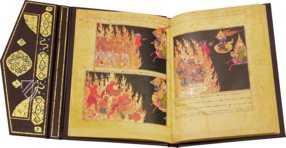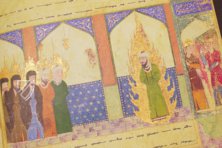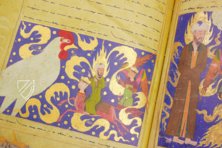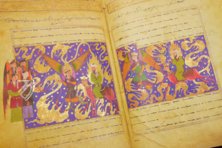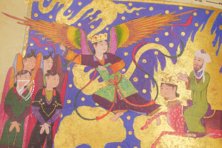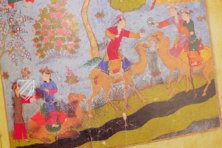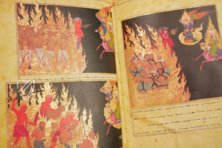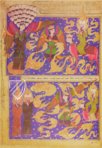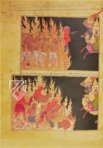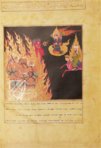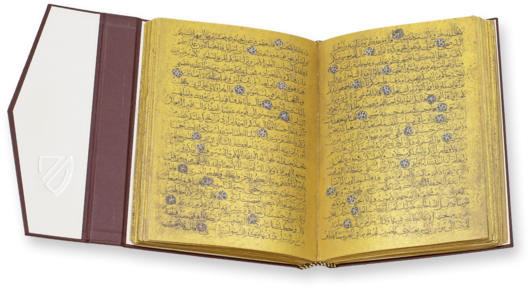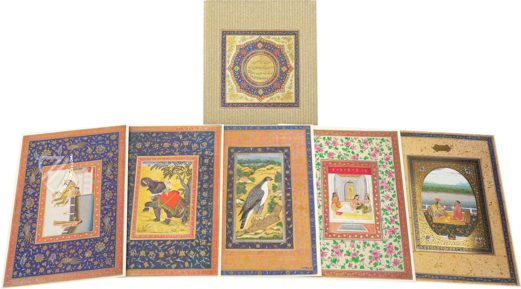Mi’ragnama: The Apocalypse of Mohamed
(3,000€ - 7,000€)
This richly illuminated Uyghur manuscript relates the story of the ascendance of the Prophet Muhammed together with the Angel Gabriel, which is illustrated by 61 magnificent miniatures with rich, opaque colors and shimmering gold leaf. Together with the Angel, Mohammed embarks thereafter on a journey towards heaven, wherein he visits the various spheres and parts of heaven. The manuscript originated in Herat, Afghanistan ca. 1436 at the behest of Shah Rukh, who was an important patron of the arts as well as being a son of the famous Timur, founder of the Timurid Empire. Its décor is a wonderful mix of Arabic and Central Asian artistic influences resulting from the cultural boom that occurred under the Timurid dynasty. The manuscript is one of the rare works to defy the Islamic ban on visual depictions of the prophet Mohammad.
Mi’ragnama: The Apocalypse of Mohamed
A meaningful testimony of Islamic and Central Asian manuscript art is found in the National Library of France in Paris: also known as Miraj-Name, this grandly illustrated manuscript depicts the ascension of Mohammed. The Uyghur manuscript from the 15th century retains its colorfully magnificent miniatures of the rarely pictorially depicted Islamic prophet. In wondrous, very ornamental, and also realistically designed pictures, the story of Mohammed is explained, who explores the different spheres of Heaven with the angel Gabriel.
A Grand Testimony to Timurid Art
Originating ca. 1436 in Herat, in modern day Afghanistan, the so-called Mi’ragnama stands as a premier example of 16th century oriental manuscript art. It was allegedly finished for Shah Rukh, an important patron. He was the son of Timur, the founders of the Timurid Dynasty in Central Asian, which today consists of the areas of Afghanistan, Iran, and Uzbekistan. A cultural bloom occurred within the empire under his rule, especially in the area of literature and art. Despite Islam’s prohibition of pictures of Mohammed, if anything he was depicted with a masked face, the first drawings of the Prophet appeared ca. 1300. The miniatures of the Paris Mi’ragnama show him in a circle with other people, with only one of them having an open face.
The Wondrous Story of Mohammed’s Ascendance
The gorgeous manuscript of the Mi’ragnama was presumably made by the Timurid Baysungur. The text is not in Arabic, but rather composed in the Uyghur language, which indicates the development of the national language of the Timurid Court. Still, the actual highpoints of the manuscript are the 61 miniatures. The story of the ascendance of the Prophet Muhammed together with the Angel Gabriel is explained in unbelievably striking ways. The Angel Gabriel’s visit with Mohammed and his subsequent invitation to his ascendance is depicted. Together with the Angel, Mohammed embarks thereafter on a journey towards heaven, wherein he visits the various spheres and parts of heaven. These events are depicted in multiple ways in the countless miniatures. The ornamental design of the grandly colored miniatures are quite impressive. Not only is the background often rather ornamentally decorated, even the sky with its constant white clouds appear beautifully. The large formatted images are raised in their magnificence and splendor through the rich application of gold. The Islamic style of painting, especially clear through the ornamentation and all of the gold, mixes itself excitingly with Central Asian influences. Thus, a very impressive depiction of the Ascendance of the Prophet Mohammed is made available not only to Muslims, but for Western observers as well.
Codicology
- Alternative Titles
- Miraj Nameh
Mi‘rajnama: The Book of the Prophet Muhammads' Ascension
Mi´ragnama: Apocalipsis de Mahoma
Miradschname: Das Buch der Himmelfahrt des Propheten Mohammed
Le Livre de l'Ascension du Prophète Mahommed
Il Libro dell’Ascensione del Profeta Maometto
O livro da Ascensão do Profeta Maomé - Type
- Manuscript on paper
- Size / Format
- 70 pages / 34.5 × 24.5 cm
- Origin
- Afghanistan
- Date
- Ca. 1436–1437
- Epochs
- Style
- Illustrations
- 61 full-page miniatures illuminated in gold
- Content
- Redacted version of the "The Miraculous Journey of Mohammed"
- Patron
- Timurid Emperor Shah Rukh (1377–1447)
- Artist / School
- Mir Haydar (author)
Malik Bakhshi of Herat (scribe) - Previous Owners
- Jean-Baptiste Colbert (1619–83)
Mi’ragnama: The Apocalypse of Mohamed
Zaqqoum, Tree of Hell
Upon arriving in Hell, the angel Gabriel shows Muhammad the Zaqqoum. It is a horrific tree covered with thorns and its fruits are demon heads – represented here by the heads of various animals both real and fantastic. The residents of Hell are forced to eat this cursed fruit, but they receive no sustenance from it. A blue demon with red eyes, a flaming halo, and wearing gold jewelry guards it as immoral and deceitful lawyers are shown having their tongues cut out and thrown into a brazier.

Mi’ragnama: The Apocalypse of Mohamed
Ascent of Muhammad to Heaven
According to Islamic tradition, Muhammad was taken on a spiritual and physical journey in the course of one night, first going from Mecca to Jerusalem and from there ascending into Heaven. Muhammad rode on the back of a Buraq – a white winged beast resembling a mule. The depiction of the Buraq with a crowned human face indicates a Persian influence in this rare and precious Uyghur manuscript.
Preceded by an elaborate header and tightly-written text, this miniature is a kaleidoscope of rich primary colors and gold leaf, which is used to depict the swirling clouds. While Muhammed is dressed in a simple green tunic, the angels wear elaborate garments with fine patterns and their wings are rendered with different colors on each side.
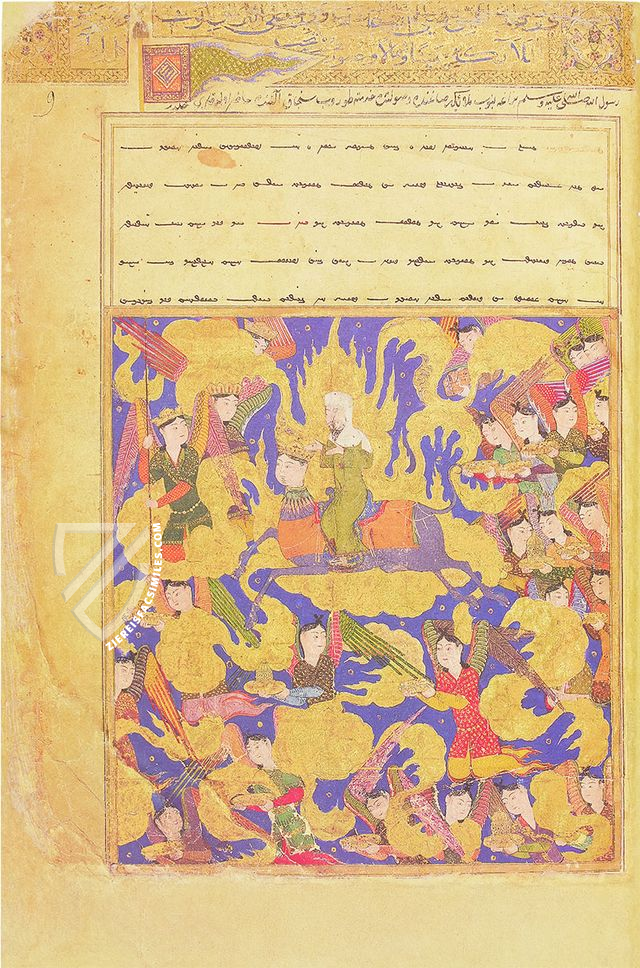
#1 Mi´ragnama - Apocalipsis de Mahoma
Languages: Spanish, English
(3,000€ - 7,000€)
- Treatises / Secular Books
- Apocalypses / Beatus
- Astronomy / Astrology
- Bestiaries
- Bibles / Gospels
- Chronicles / History / Law
- Geography / Maps
- Saints' Lives
- Islam / Oriental
- Judaism / Hebrew
- Single Leaf Collections
- Leonardo da Vinci
- Literature / Poetry
- Liturgical Manuscripts
- Medicine / Botany / Alchemy
- Music
- Mythology / Prophecies
- Psalters
- Other Religious Books
- Games / Hunting
- Private Devotion Books
- Other Genres
- Afghanistan
- Armenia
- Austria
- Belgium
- Belize
- Bosnia and Herzegovina
- China
- Colombia
- Costa Rica
- Croatia
- Cyprus
- Czech Republic
- Denmark
- Egypt
- El Salvador
- Ethiopia
- France
- Germany
- Greece
- Guatemala
- Honduras
- Hungary
- India
- Iran
- Iraq
- Israel
- Italy
- Japan
- Jordan
- Kazakhstan
- Kyrgyzstan
- Lebanon
- Liechtenstein
- Luxembourg
- Mexico
- Morocco
- Netherlands
- Palestine
- Panama
- Peru
- Poland
- Portugal
- Romania
- Russia
- Serbia
- Spain
- Sri Lanka
- Sweden
- Switzerland
- Syria
- Tajikistan
- Turkey
- Turkmenistan
- Ukraine
- United Kingdom
- United States
- Uzbekistan
- Vatican City
- A. Oosthoek, van Holkema & Warendorf
- Aboca Museum
- Ajuntament de Valencia
- Akademie Verlag
- Akademische Druck- u. Verlagsanstalt (ADEVA)
- Aldo Ausilio Editore - Bottega d’Erasmo
- Alecto Historical Editions
- Alkuin Verlag
- Almqvist & Wiksell
- Amilcare Pizzi
- Andreas & Andreas Verlagsbuchhandlung
- Archa 90
- Archiv Verlag
- Archivi Edizioni
- Arnold Verlag
- ARS
- Ars Magna
- ArtCodex
- AyN Ediciones
- Azimuth Editions
- Badenia Verlag
- Bärenreiter-Verlag
- Belser Verlag
- Belser Verlag / WK Wertkontor
- Benziger Verlag
- Bernardinum Wydawnictwo
- BiblioGemma
- Biblioteca Apostolica Vaticana (Vaticanstadt, Vaticanstadt)
- Bibliotheca Palatina Faksimile Verlag
- Bibliotheca Rara
- Boydell & Brewer
- Bramante Edizioni
- Bredius Genootschap
- Brepols Publishers
- British Library
- C. Weckesser
- Caixa Catalunya
- Canesi
- CAPSA, Ars Scriptoria
- Caratzas Brothers, Publishers
- Carus Verlag
- Casamassima Libri
- Centrum Cartographie Verlag GmbH
- Chavane Verlag
- Christian Brandstätter Verlag
- Circulo Cientifico
- Club Bibliófilo Versol
- Club du Livre
- CM Editores
- Collegium Graphicum
- Collezione Apocrifa Da Vinci
- Comissão Nacional para as Comemorações dos Descobrimentos Portugueses
- Coron Verlag
- Corvina
- CTHS
- D. S. Brewer
- Damon
- De Agostini/UTET
- De Nederlandsche Boekhandel
- De Schutter
- Deuschle & Stemmle
- Deutscher Verlag für Kunstwissenschaft
- DIAMM
- Droz
- E. Schreiber Graphische Kunstanstalten
- Ediciones Boreal
- Ediciones Grial
- Ediclube
- Edições Inapa
- Edilan
- Editalia
- Edition Deuschle
- Edition Georg Popp
- Edition Leipzig
- Edition Libri Illustri
- Editiones Reales Sitios S. L.
- Éditions de l'Oiseau Lyre
- Editions Medicina Rara
- Editorial Casariego
- Editorial Mintzoa
- Editrice Antenore
- Editrice Velar
- Edizioni Edison
- Egeria, S.L.
- Eikon Editores
- Electa
- Emery Walker Limited
- Enciclopèdia Catalana
- Eos-Verlag
- Ephesus Publishing
- Ernst Battenberg
- Eugrammia Press
- Extraordinary Editions
- Fackelverlag
- Facsimila Art & Edition
- Facsimile Editions Ltd.
- Facsimilia Art & Edition Ebert KG
- Faksimile Verlag
- Feuermann Verlag
- Folger Shakespeare Library
- Franco Cosimo Panini Editore
- Friedrich Wittig Verlag
- Fundación Hullera Vasco-Leonesa
- G. Braziller
- Gabriele Mazzotta Editore
- Gebr. Mann Verlag
- Gesellschaft für graphische Industrie
- Getty Research Institute
- Giovanni Domenico de Rossi
- Giunti Editore
- Graffiti
- Grafica European Center of Fine Arts
- Guido Pressler
- Guillermo Blazquez
- Gustav Kiepenheuer
- H. N. Abrams
- Harrassowitz
- Harvard University Press
- Helikon
- Hendrickson Publishers
- Henning Oppermann
- Herder Verlag
- Hes & De Graaf Publishers
- Hoepli
- Holbein-Verlag
- Houghton Library
- Hugo Schmidt Verlag
- Idion Verlag
- Il Bulino, edizioni d'arte
- ILte
- Imago
- Insel Verlag
- Insel-Verlag Anton Kippenberger
- Instituto de Estudios Altoaragoneses
- Instituto Nacional de Antropología e Historia
- Introligatornia Budnik Jerzy
- Istituto dell'Enciclopedia Italiana - Treccani
- Istituto Ellenico di Studi Bizantini e Postbizantini
- Istituto Geografico De Agostini
- Istituto Poligrafico e Zecca dello Stato
- Italarte Art Establishments
- Jan Thorbecke Verlag
- Johnson Reprint Corporation
- Josef Stocker
- Josef Stocker-Schmid
- Jugoslavija
- Karl W. Hiersemann
- Kasper Straube
- Kaydeda Ediciones
- Kindler Verlag / Coron Verlag
- Kodansha International Ltd.
- Konrad Kölbl Verlag
- Kurt Wolff Verlag
- La Liberia dello Stato
- La Linea Editrice
- La Meta Editore
- Lambert Schneider
- Landeskreditbank Baden-Württemberg
- Leo S. Olschki
- Les Incunables
- Liber Artis
- Library of Congress
- Libreria Musicale Italiana
- Lichtdruck
- Lito Immagine Editore
- Lumen Artis
- Lund Humphries
- M. Moleiro Editor
- Maison des Sciences de l'homme et de la société de Poitiers
- Manuscriptum
- Martinus Nijhoff
- Maruzen-Yushodo Co. Ltd.
- MASA
- Massada Publishers
- McGraw-Hill
- Metropolitan Museum of Art
- Militos
- Millennium Liber
- Müller & Schindler
- Nahar - Stavit
- Nahar and Steimatzky
- National Library of Wales
- Neri Pozza
- Nova Charta
- Oceanum Verlag
- Odeon
- Orbis Mediaevalis
- Orbis Pictus
- Österreichische Staatsdruckerei
- Oxford University Press
- Pageant Books
- Parzellers Buchverlag
- Patrimonio Ediciones
- Pattloch Verlag
- PIAF
- Pieper Verlag
- Plon-Nourrit et cie
- Poligrafiche Bolis
- Presses Universitaires de Strasbourg
- Prestel Verlag
- Princeton University Press
- Prisma Verlag
- Priuli & Verlucca, editori
- Pro Sport Verlag
- Propyläen Verlag
- Pytheas Books
- Quaternio Verlag Luzern
- Reales Sitios
- Recht-Verlag
- Reichert Verlag
- Reichsdruckerei
- Reprint Verlag
- Riehn & Reusch
- Roberto Vattori Editore
- Rosenkilde and Bagger
- Roxburghe Club
- Salerno Editrice
- Saltellus Press
- Sandoz
- Sarajevo Svjetlost
- Schöck ArtPrint Kft.
- Schulsinger Brothers
- Scolar Press
- Scrinium
- Scripta Maneant
- Scriptorium
- Shazar
- Siloé, arte y bibliofilia
- SISMEL - Edizioni del Galluzzo
- Sociedad Mexicana de Antropología
- Société des Bibliophiles & Iconophiles de Belgique
- Soncin Publishing
- Sorli Ediciones
- Stainer and Bell
- Studer
- Styria Verlag
- Sumptibus Pragopress
- Szegedi Tudomànyegyetem
- Taberna Libraria
- Tarshish Books
- Taschen
- Tempus Libri
- Testimonio Compañía Editorial
- Thames and Hudson
- The Clear Vue Publishing Partnership Limited
- The Facsimile Codex
- The Folio Society
- The Marquess of Normanby
- The Richard III and Yorkist History Trust
- Tip.Le.Co
- TouchArt
- TREC Publishing House
- TRI Publishing Co.
- Trident Editore
- Tuliba Collection
- Typis Regiae Officinae Polygraphicae
- Union Verlag Berlin
- Universidad de Granada
- University of California Press
- University of Chicago Press
- Urs Graf
- Vallecchi
- Van Wijnen
- VCH, Acta Humaniora
- VDI Verlag
- VEB Deutscher Verlag für Musik
- Verlag Anton Pustet / Andreas Verlag
- Verlag Bibliophile Drucke Josef Stocker
- Verlag der Münchner Drucke
- Verlag für Regionalgeschichte
- Verlag Styria
- Vicent Garcia Editores
- W. Turnowski Ltd.
- W. Turnowsky
- Waanders Printers
- Wiener Mechitharisten-Congregation (Wien, Österreich)
- Wissenschaftliche Buchgesellschaft
- Wissenschaftliche Verlagsgesellschaft
- Wydawnictwo Dolnoslaskie
- Xuntanza Editorial
- Zakład Narodowy
- Zollikofer AG




